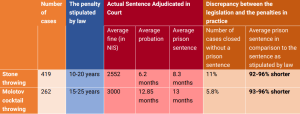
- Stone and Molotov cocktail throwing in Judea and Samaria has evolved from a nuisance to a strategic challenge that undermines the safety of the civil population and contributes to the stability and motivation of Palestinian Jihad. As such, this challenge requires a comprehensive, multilayered systemic response.
- The extent of this phenomenon indicates that these are not merely isolated incidents, but the tip of the iceberg, and indicate systemic institutional incitement for Jihad against Israel, led by the Palestinian Authority, Hamas,
- These are the most common forms of terrorism based on the availability of weapons, daily interaction with the population, alongside the absence of operational and legal deterrence.
- There are currently about 20 known hotspots of stone-throwing, mostly along the main routes, as well as specific locations of persistent rioting along the separation barrier (“West Bank Barrier”). The perpetrators are typically aged 10-20, attack IDF units, at times encouraged by local inciters and radical militant organizations.
- 2020 saw 1,884 stone-throwing incidents and 496 Molotov cocktail throwing incidents, causing injury to 154 soldiers and civilians. On average, in 2021, stone throwing incidents increased by 210%, and Molotov Cocktail throwing incidents increased by 156% year on year.
- The IDF and the Israeli Police are responding to this threat by ambushing and dispersing these terrorists’ gangs, and placing them in detention. The main challenges in tackling this problem include the density of the areas from which the terror attacks are carried out, local assistance to the perpetrators, the profusion of hotspots where the security forces are required to operate, the operational ineffectiveness of the IDF’s tools in dealing with this phenomenon, non-detention or release from detention of the perpetrators, cumbersome rules of engagement, and judicial procedures that lead to lenient sentences.
- A review of all cases opened against perpetrators from 2019 to 2020 showed a clear picture of significant leniency in the civil and military courts, with much lighter penalties than what the law calls for, to the extent that prison sentences are 95% shorter than the sentences provided by law. In some cases, sentences are dispensed for only several days to several months of incarceration.11% of the stone-throwing cases do not end in incarceration at all. The circumstances of the verdicts are unknown and require a case-by-case review.
- The average sentence is 3 months for stone throwing and 13 months for Molotov cocktails, in contrast to the maximum sentence stipulated by law – 10-25 years, depending on the circumstances.
- Furthermore, a comparative analysis of the data revealed that a significant portion of reported incidents does not end with an indictment. During the first half of 2020, only 21% of the reported stone-throwing incidents and 33% of the Molotov cocktail incidents have ended with an indictment.
- The obstacles in addressing this challenge include a lack of coordination between units, a shortage of investigators and combat soldiers, intelligence gaps, and a “widely-accepted penalty range” culture in courts that is not in line with the dictates of the law.
- Our recommendations include the following: Defining specific areas as high-risk areas for stone and Molotov cocktail casualties., where this constitutes a life-risking terror attack which justifies defensive actions such as shooting for the purpose of neutralizing; concentrated efforts to detain the recruiters, inciters, and instructors of perpetrators; A computerized system with a database that enables improved coordination; and formulating legislation that enables more severe and just penalties for those involved in terror activities.
The IDSF has had a security briefing webinar with 27 representatives from foreign embassies in Israel based on this position paper, exposing them to the truth on the unbearable everyday reality in the Judea and Samaria roads.